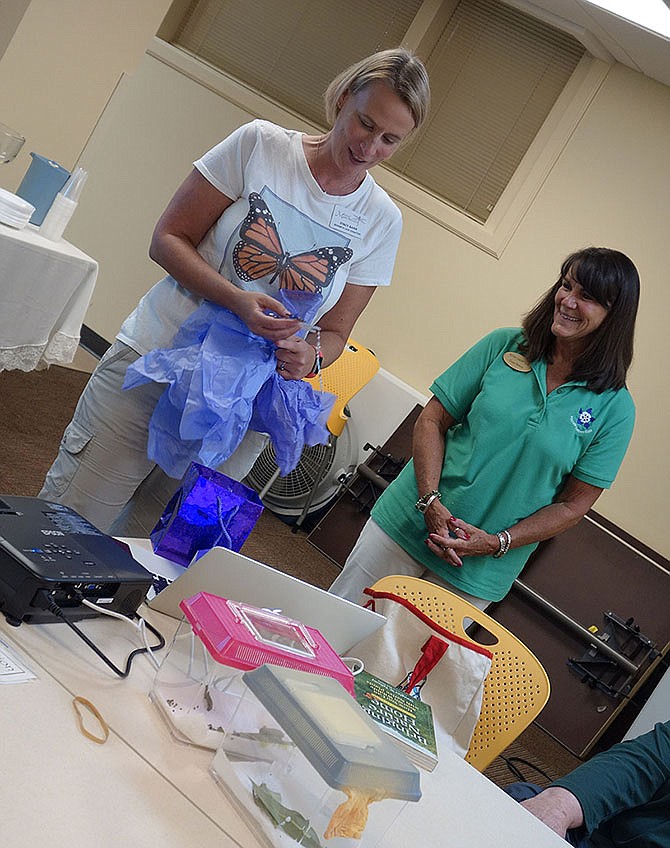While some monarch butterfly populations in western parts of the United States and even the world are maintaining healthy numbers, those seen in places like Missouri are having their ups and downs.
Loss of habitat, both in the summer and winter homelands, is part of the problem, according to Stacey Barr, Boones Lick master naturalist and team leader for Missourians for Monarchs. Other problems include pesticides and predators, she said.
"Their numbers in our part of the country are in jeopardy," Barr said to a group assembled last week at Callaway County library in Fulton. "Those in the most danger seem to be the migrating population on the eastern half of the United States."
When breeding, a monarch will lay 200 to 500 eggs, attemping to space them to have room and enough to eat as hungry caterpillars.
"Only two to five eggs out of 100 will survive to adulthood," Barr said. "There's a lot of stuff going against them."
These eggs will hatch in three to four days, and the future butterflies will spend 10-14 days as caterpillars stuffing themselves and growing. During that time, they will shed their skins - and they also spin silk, leaving a faint trail wherever they go.
The final stage of the transformation is the pupal stage, a smooth, jade green bulb inside which the caterpillar becomes the butterfly. They remain in this stage 10-14 days, as well.
"You'll find them in the weirdest spots," Barr said. "I'll find them in my house under the leg of a chair or on the edge of a flowerpot - just about anywhere."
The pupa becomes translucent just before the monarch emerges upside down.
"They pop out head first with their wings crumpled up, and their abdomen is filled with fluid, used for pumping up their wings," Barr said. "It takes four to five hours for their wings to dry, and they're ready to fly."
Most birds won't touch a monarch butterfly.
"They're very brightly colored," Barr said of their orange and black coloring. "That means 'I taste bad. I will make you sick.' Orange and black means stay away."
The females have thicker black veins in their wings, and the males have a single black spot on each of their hind wings. The butterflies are sexually active within three to four days, and the process starts all over again.
"They generally live four to six weeks," Barr added. "From egg to adult butterfly takes about one month."
Monarchs who migrate to their winter home in Mexico's central highlands live longer, however, because of delayed reproductive activity. They may live eight or nine months before starting north to Canada in the spring.
Barr said she started planting native plants at her property near Columbia and then read a book, "Bringing Nature Home."
"This book changed everything," she said.
She discovered a monarch caterpillar on a milkweed plant one August and that's how she started raising them. In 2015, Barr raised and released 250 monarch butterflies.
This peak migration time in Central Missouri, Barr added.
"We should be seeing clouds of them," she said. "They'll get up on the thermals, in the drafts. They're not really flying. They're not flapping their wings down the interstate."
It's more like they're floating to Mexico, Barr said.
"They can go 40, 50 sometimes up to 80 miles in one day; it depends if they get a good tailwind," she added.
As they float south, the monarchs come down to earth to eat on plants such as milkweed, goldenrod and other nectar-producing plants.
"They actually gain weight as they're flying south," Barr said. "There's actually little food for them in Mexico, and so they're living off their reserves."
Last March, just as the monarchs were preparing to migrate north again, an ice storm decimated their habitat in Mexico, Barr said.
"It may have killed half the population," she said, adding the storm also killed many of their preferred trees.
For Barr, raising monarchs helps her feel as if she's giving them a chance to survive.
"I know if I bring them in, I will have a 95 percent success rate," she said. "Last year, I released 250. Think about it. That would have been about four that would have survived if I hadn't brought them in."
She said she also worries about recent spraying of insecticides to kills mosquitoes infected with the Zika virus. Barr hopes a better way can be found.
"We have to come to our senses," she said of this spraying - said to be the cause of a recent, massive honey bee kill in South Carolina. "It's scary."
Barr said while some people who help raise monarchs feel sad letting them go, she feels satisfied.
"I feel like this is what they're born to do," she said, thinking of her own orange and black babies. "I'm just sure all of them make it down to Mexico."
Many organizations have information about monarchs, their stages of life and how to help them out. One is Monarchwatch.org, which helps track the fall migration. Other organizations are Journeynorth.org and wildones.org.

